
The numbers are dramatic.
Eighty-nine percent of B2B marketers are using content marketing, but only 19% say they’ve been “very successful” with their efforts.
Consistency is key to a high-performing content marketing campaign. According to Content Marketing Institute, 85% of top performers deliver content consistently, compared to 32% of bottom performers.
But content consistency requires time, creativity and research to execute effectively, and it all starts by generating the actual content marketing ideas. To help, we’ve compiled a list of 40 of ’em to inspire you, categorized by blogs, emails and lead generation content for easy identification.
Blogs fall under the awareness or attraction phase of content marketing and their purpose is to educate new visitors to your site, identify their problems and connect them with your brand.
Lead generation content is meant to capture leads from people who are already familiar with your brand and have crossed the awareness stage. This type of content solves your audiences’ problems and issues.
Emails can be used to engage your current customers or prospects and massage relationships to birth new customers and increased loyalty.
Note that just because a piece of content falls under one category, doesn’t mean that it cannot be used for another. It’s more important to tailor your content to whatever stage of the sales cycle your prospect is in, regardless of what type it is.
We’ve also listed a DIY Difficulty Rating below each content marketing idea. The scale ranges from 1-5 (5 indicating an expert/pro is necessary for this, 1 is easy to do it yourself). I added this scale so you can gauge whether or not you want to create a specific type of content depending on its difficulty. This will allow you to more effectively prioritize your ideas.
Ready? Here we go!
Blogging
Below, you will find several content ideas for your B2B blog:
1. How-To Posts (DIY Difficulty: 2)
The classic “How To” post never gets old. The most popular how-to articles are in-depth pieces that border on tutorials.
This piece does not require any technical ability, but it needs to be in-depth, detailed and thorough enough to make an impact. Use videos and images where applicable.
2. FAQ (Frequently Asked Questions) (DIY Difficulty: 2)
If your readers have questions, give them answers! What are the most frequently asked questions in your industry? To find some FAQs, research popular Q&A sites like Quora and Yahoo Answers. If you have a sales or customer service team, poll them for more detailed customer questions.
This piece requires a little research but it is easy to craft.
3. Getting Started Guides (DIY Difficulty: 2)
“Getting started” content is easy to neglect as businesses forget that their audience may also include subject-matter novices. Address the novices as they are often confused with top-level content. Ensure this content is easy to understand, in-depth and thorough.
This post may require some research, but it will be easy to create as the content is at an elementary level.
4. Industry Books (DIY Difficulty: 1)

What are the most popular books in your industry? Compile a list and write about them. Include images of the books and link to each one for easy access.
These posts are easy to craft and they are typically not long.
5. Event Re-caps (DIY Difficulty: 3)
Industry events are commonplace. I just attended a free webinar event via Hubspot Academy and event conversations took place on Twitter.

If you search for the hashtag #hubspotmasterclass on Twitter, you will find insights people gleaned from the event. Gather takeaways/insights from other tweeters during these events and compile them into a post. Link back to each Twitter account you mention.
This also works for in-person events. If your business attended an industry event, take notes and pics during the event and create a re-cap post after. Include your personal business takeaways to position your business as a fellow industry expert.
Event posts require some research and collaboration, especially if you are compiling in-person event information. They are powerful pieces that provide high value to readers who were unable to attend the events.
Don’t stop now! We’ve got 35 more great ideas to help boost your business!
6. Podcasts (DIY Difficulty: 5)Brands use podcasts to disseminate helpful industry information to their readers or interview influencers. Podcasts not only help to drive traffic and create brand awareness, but you can also use them as lead generation tools and end each audio with a call to action to receive a piece of free content.To do podcasts right, you will need some technical know-how around what audio/editing equipment to use and hosting.
7. Infographics (DIY Difficulty: 1-4)
Infographics comprise some of the internet’s most beloved images. They provide high-value content pictorially so readers can visually grasp the content. Infographic content can include anything that resonates with your audience, from helpful tips and how-tos to interesting stats and research.
I gave infographics a 1-4 rating because the difficulty depends on how much customization you want. If you curate an infographic from another site, this is easy, yet it isn’t custom (Difficulty: 1). If you use a program such as Piktochart or Venngage, you can create the infographics yourself even if you are not a designer (Difficulty: 2-3). But if you want more custom graphics, it will require knowledge of a graphic design program like Photoshop (Difficulty: 4) or you can hire a designer to create it.
8. Behind the Scenes (DIY Difficulty: 1)

Take readers behind the scenes of your establishment. Post images of your workspaces, whiteboards, break rooms or anywhere “hidden” to your online audience.
These posts are easy to craft and they are typically not long.
9. Round-up Posts (DIY Difficulty: 2-3)
Who are the best influencers in your space? What are the top blogs on a specific subject? “Round up” the best of the best and post about it.
These posts are easy to craft, yet expert roundups require connecting with influencers and getting them to contribute. A quicker round-up would involve combing the web and curating experts’ content already published, but posting fresh content will attract more shares and buzz.
10. Internal Round-up (DIY Difficulty: 1)
Periodically, create a round-up for your most popular posts. This is not only an easy way to create valuable content but it also keeps your best content top of mind for your audience.
These posts are easy to craft and they are typically not long.
11. Insider Information (DIY Difficulty: 2)
Did you implement a strategy that resulted in a positive win? Post about it! Be transparent and post about the results of your win and exactly how it happened. These types of posts tend to do well as not a lot of businesses are transparent about their strategies.
Neil Patel regularly creates these insider posts and includes personal screenshots. In this post, he details his daily Facebook ad spend and how he runs his campaigns.
This piece is not difficult to create but it should be long enough to satisfy the topic. The more detailed, actionable advice you can give away, the better.
12. Influencer Interviews (DIY Difficulty: 3)

Capitalize on an influencer’s popularity by conducting an interview with one. Here’s some tips on how to get an influencer to notice you and not throw away your email in the virtual wastebasket.
This one requires a little preliminary work, but if you can land a great influencer, you can use the interview as either featured blog content or an epic lead generation piece depending on how influential the person is.
13. Useful Tools (DIY Difficulty: 2)
Do you use any useful tools in your day-to-day business that have made your life easier? If so, let your audience know about it. Similar to the “insider information” posts, be as transparent as possible and display screenshots of how you use the tools. Give your readers detailed, actionable advice.
This piece is not difficult to create but it should be long enough to satisfy the topic. The more detailed, actionable advice you can give away, the better
14. Popular Blog Post – Follow-up (DIY Difficulty: 1)
Do you have any popular blog posts? Capitalize on their success and create a follow-up post detailing additional content and information.
This piece is easy to create as you already have a foundation of content to create it from (original popular post). Simply expound upon the original and provide more great content.
15. Customer Spotlight (DIY Difficulty: 2)

Customer spotlights help brands connect with potential customers by featuring how customers use their products. Spotlights can also tell customer stories and instill a human dimension to your blog or website.
This piece is not difficult to create but it will require an interview with a willing customer and a detailed write-up.
16. Company News (DIY Difficulty: 1)
Anything new happening? Share it! Keep your content audience in the loop on what is happening with your company. New buzz is always a good idea. It keeps your company looking active and fresh.
These posts are typically short news pieces and they are easy to create. Add images for increased engagement and authenticity.
17. Slideshare (DIY Difficulty: 2-4)
Slideshare is popular in the B2B space and businesses use it to publish high-quality graphical presentations to increase brand awareness and gain leads (Pro users can add lead gen forms). Upload eBooks, infographics and even videos to a Slideshare presentation.
This process will get more difficult if you need custom images or videos created. In that case, hire a graphic designer or a video creator/editor. If you want to keep it simple, upload a Powerpoint presentation or eBooks you already have and add them to the Slideshare platform to publish it in a different format.
18. Future Trends (DIY Difficulty: 1-2)
Businesses that predict future trends are thought to be industry leaders. Brands typically publish future trend articles at the beginning of every new year and predict the new year’s trends.
These posts are easy to create if you are engrossed in your industry and you are aware of how it is trending. You can curate trends (easier) but you’ll get more accolades if you can come up with your own.
19. Guest Bloggers (DIY Difficulty: 1)
If your blog gets a good amount of traffic, you may receive requests from bloggers who want to write guest posts. This can help relieve the content creation pressure a bit, which is helpful, but ensure the blogger understands your brand and the value of the content you post.
The process is easy since you are not writing the post but send the content through a strict editing process so it aligns with your brand in terms of messaging and value.
20. Product Reviews / Ratings (DIY Difficulty: 2)
Offer detailed reviews of products/services your readers would use. We do this at Media Shower occasionally. Here is a post about the ratings for the top 7 content automation platforms for 2017.
The piece will require some preliminary research depending on whether or not you have used the tools yourself.
Emails
An email list is gold to a content marketer. Cherish your subscribers and they will give back. Here are some examples of emails you can send depending on your type of business:
21. Newsletters (DIY Difficulty: 2-3)
Create a monthly or weekly newsletter. The typical internet user gets 120 business emails and 105 personal emails a day. Your email will be fighting for your subscriber’s attention and a newsletter can keep your content at the forefront. Use your newsletter to offer helpful information, subscriber-only offers, links to popular blog posts and any exciting company news.
Halton, Pardee + Partners, a real estate brokerage firm in West LA, sends periodic newsletters announcing featured home listings, videos, industry news, and fun articles.

Crafting newsletters takes some compilation and graphics which will require more time and expertise. If you create a newsletter based on templates in your email program such as Aweber or GetResponse, the task will be easier. However, your newsletter may not be branded if you use a template.
22. Offers and Discounts (DIY Difficulty: 1-2)
Make your subscribers feel special by offering special discounts to them. Free shipping is a crowd-pleaser as well as large discounts on substantial purchases.
These emails are easy to write but if you use custom graphics, you may need a design expert. You can also try DIY graphics programs such as Canva and Pablo.
23. Earlybird Access (DIY Difficulty: 1-2)
Are you launching a new product soon? Give your subscribers early access and create some buzz around your new launch.
These emails are easy to write but if you use custom graphics, you may need a design expert.
24. Thank You (DIY Difficulty: 1)
Gratitude goes a long way. Thank your subscribers for being a part of your brand and make them feel connected and welcomed.
Thank you emails can be as simple as plain text. If you want to get fancier, consider some of the graphics tools I discussed above.
Lead Generation
Use the following content pieces to get leads and subscribers to your email list. Offer them for free in exchange for personal information and a subscription to your email list. Lead generation content should be high-value and solve a deep need of your target audience.
25. eBooks (DIY Difficulty: 2-3)
Offer an eBook on a topic that is important to your audience. The book does not have to be super long; 10-20 pages will suffice as long as it flushes out the topic fully. Quality is more important than quantity.
If you are not a writer, hire a content creator who has experience creating eBooks. Your book should be professionally written and also include graphics (can be simple). Simple graphics will include adding images throughout with a professional footer, header, cover page and table of contents. If you want to make the eBook more visually stunning, you may need to consult with a design expert.
26. Industry Reports (DIY Difficulty: 2-3)
Industry reports are smaller versions of eBooks. If you have 5-7 pages of content on a topic or a list of helpful resources, these would qualify as industry reports.
The same difficulty for eBooks applies to reports.
27. Live streams (DIY Difficulty: 1)
Start a live video any time you want with Facebook live and Instagram live. Use live video to generate engagement, increase brand awareness and acquire leads for any new lead offers or products.
Conducting live videos is not technically difficult, but you will need to know a little about the social platforms so you can maximize the success of your campaigns.
28. Instagram Stories – swipe up feature (DIY Difficulty: 1-2)
Instagram stories are limited-time videos that users post to their profiles. They expire in 24 hours and they can include images, videos and quick boomerang clips. Instagram recently announced a new feature (swipe up) to its Instagram stories that allows brands to use them to link to a specific piece of content. This feature is currently only available in verified accounts. Users can swipe up on their mobile screens and be taken directly to the URL specified by the Instagram account.
Though you can use this feature for lead generation, Foundr also uses this feature to send traffic to their latest blog post. Their recent Instagram story showed a series of three graphics and then prompted the user to swipe down to reveal the blog content. When users swipe down during any graphic, they are taken to the blog post. Here are the three graphics that appeared in succession, followed by the last call to action.
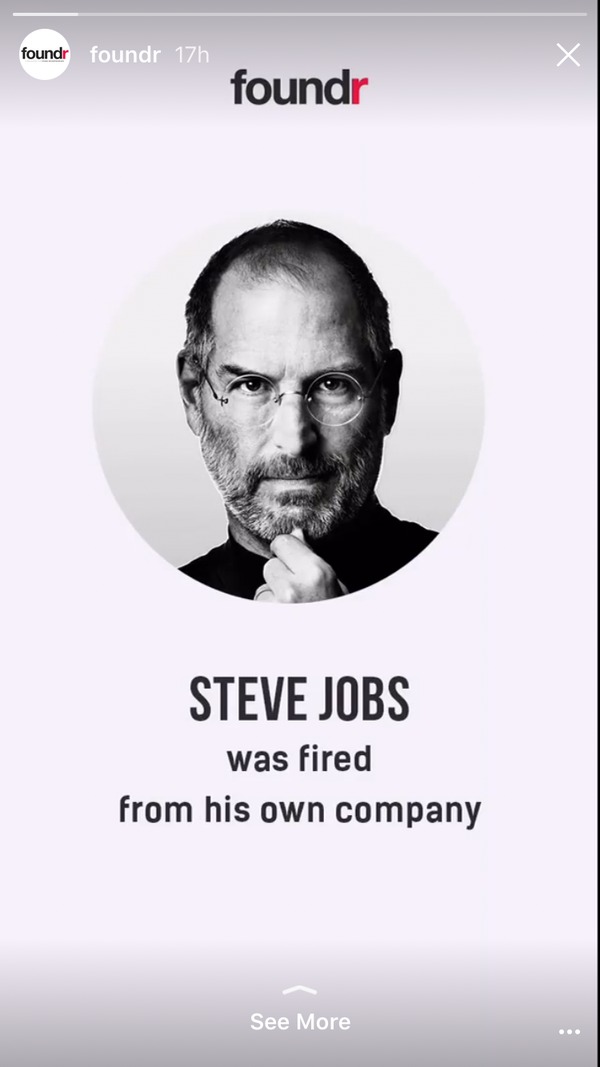
1st frame
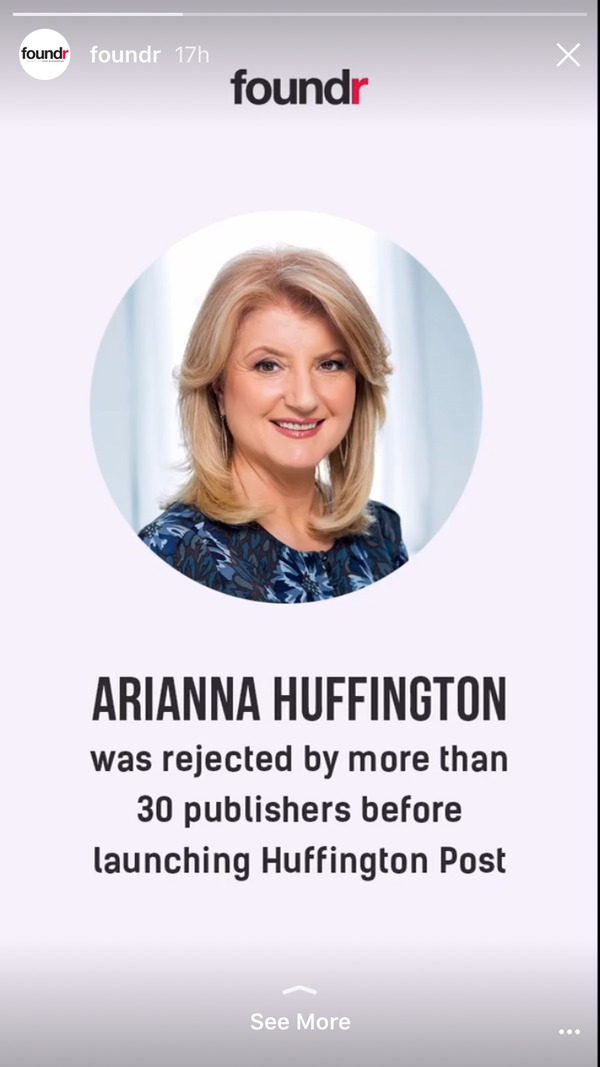
2nd frame
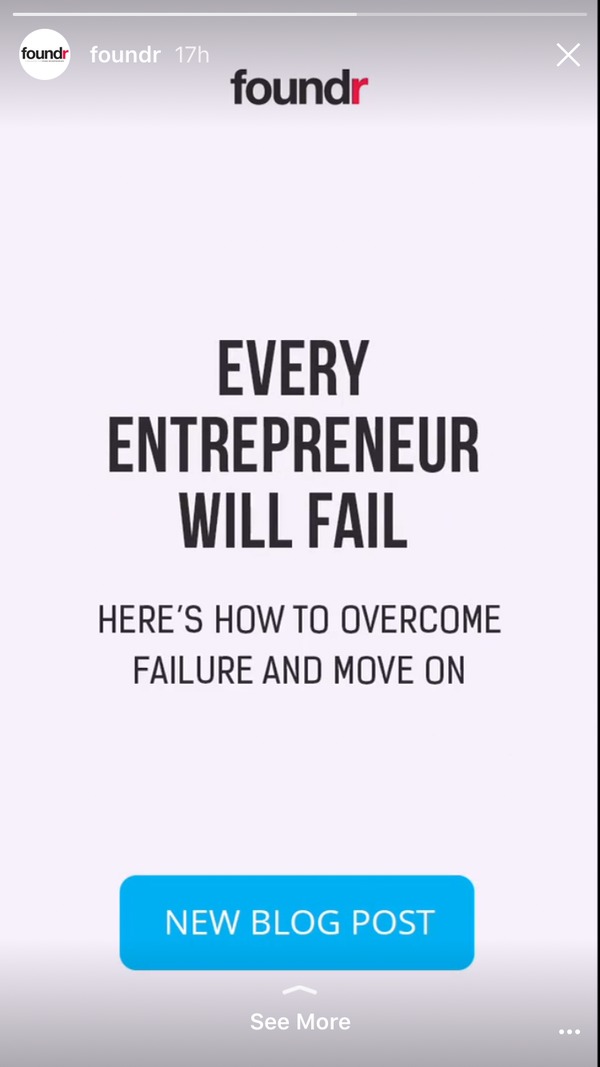
3rd frame

Last frame – Call to action
Instagram stories are easy to create. Simply click on “Your Story” on the top of your Instagram newsfeed as shown below and then follow the instructions. If you want to create Instagram stories like Foundr, you may need some custom design/video work.
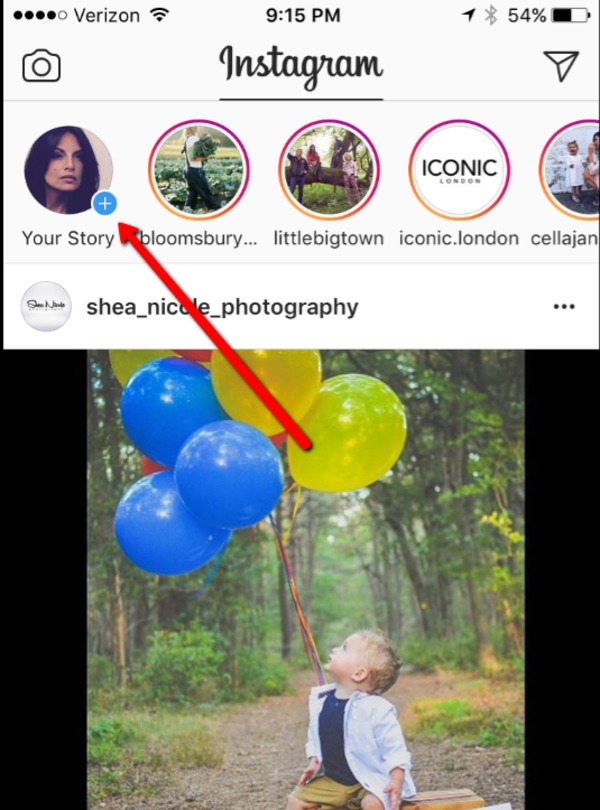
29. Quizzes
If you are on Facebook, chances are you got sucked into taking a quiz even though you knew it was meaningless. Quizzes have a way of drawing people into their cunning wiles. Businesses can use more professional quizzes to attract attention to their brand and collect email subscribers.
Creating quizzes will range from easy to difficult depending on how much custom work you want. There are platforms such as Qzzr and Riddle that will allow you to create quizzes easily by using their templates. However, you will need to produce the actual content of the quiz.
30. Whitepapers (DIY Difficulty: 2-3)
Whitepapers are an industry standard for many B2B brands. They provide authoritative, detailed content on a specific topic that addresses an industry problem. They are professional and problem-solving. Brands give away white papers in exchange for email addresses and other personal information.
White papers should be highly professional so they may require a professional writer and designer to format the report.
31. Free Service / Assessment (DIY Difficulty: 3)
Offer a free service to connect with potential prospects. At Media Shower, we give away free content marketing assessments to businesses that include specific tips on how you can promote your content and website. Consider offering something similar to your audience if you are in a services industry.
The difficulty rating is 3 because this content will require detailed research and analysis for each free service you offer. But, by over delivering with each assessment, it will allow you to engage with and attract the businesses that will be a good fit for your company.
32. Webinars (DIY Difficulty: 3)
Use webinars as educational tools to build awareness or to capture leads/sales or both. Conduct webinars at any stage of your sales cycle. Use them on your blogs to educate, as tools to gain email subscribers/leads or as a precursor to a sales close at the end.
Webinars are one of my favorite content marketing tools as they provide high-value content, often 1+ hours’ worth, and they are interactive and allow for real-time conversation.
Running webinars is not super difficult but you may need to understand some technical items before you start. Review your webinar platform and run test webinars before you switch to live.
33. Case Studies (DIY Difficulty: 2-3)
Though they can be used as blog content, businesses use case studies towards the end of the sales cycle to either gain leads or close sales. Case studies are powerful because they display the results businesses can achieve when working with you and your products/services.
Similar to whitepapers, case studies should be highly professional so they may require a professional writer and designer to format the report. You will also need to interview your customer to gather content for the case study.
34. Free Resources Page (DIY Difficulty: 2-3)
If you have multiple lead offers, compile them into a resources page like this one from Kapost:
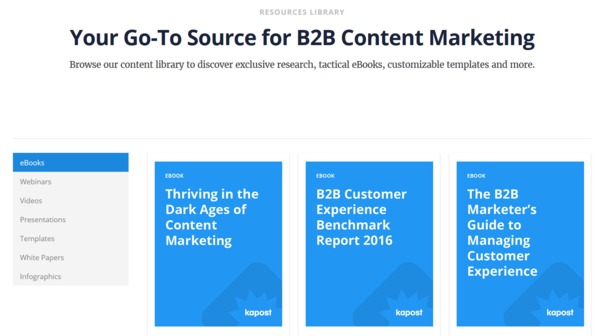
Creating a free resources page will require the work of a designer/developer if you want to go custom. If you use a CMS such as WordPress, you can create a simple page with images of your free reports linking up each image to your lead gen pages.
35. Product Demonstration (DIY Difficulty: 2)
If you are a SaaS (software as a service) provider, run free product demonstrations to showcase how businesses can use the platform to solve their problems and simplify their workflow. Gather personal information when a business requests free demos.
Product demonstrations involve setting up an account for your prospect and taking them through the platform.
36. Spreadsheets / Worksheets (DIY Difficulty: 2-3)
Create a helpful spreadsheet to simplify your target audiences’ business processes. Hubspot regularly gives away Excel worksheets in exchange for company information. Here is a page where Hubspot offers a free template to set up a Google Adwords Campaigns:
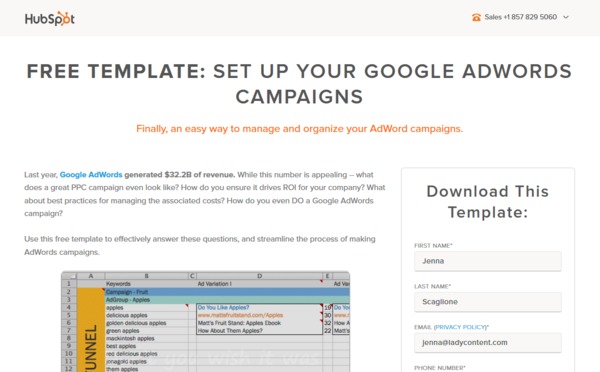
The difficulty here can range from somewhat simple to complex depending on the customization. To keep it simple, use Excel and leave out custom graphics.
37. Email Course (DIY Difficulty: 2)
Email courses are effective lead generation tools because they allow you to send a series of emails that will help keep you at the forefront of your prospect’s mind. Consider at least 10 days of emails and let your subscribers know exactly how many emails they will receive before they sign up. Buffer does this with its 25-day social media strategies email course:
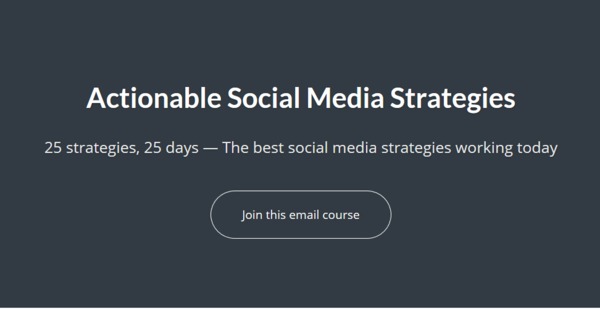
The rating here has to do with the creation of the email course. Loading it up in your email marketing program should be easy if you are already familiar with the platform. If you want to customize your emails, graphic design may be necessary, but you can also create them in plain text as well.
38. Giveaways (DIY Difficulty: 3-4)
Contests and giveaways generate a lot of buzz for brands. Consider giving away a free product or service and encourage sharing.
Running a contest can get difficult depending on how in-depth it is and how much customization you need. Some platforms that will help keep your difficulty to a minimum are Rafflecopter and Wishpond.
39. Free Trials (DIY Difficulty: 5)
If you have a SaaS, offer a free limited-time trial so people can get firsthand experience on how to use your product. Successful free trials always include detailed instructions, walkthroughs, and examples of how other businesses use the software.
If you are a Saas company, then you already have a team of developers working with you as you will need assistance setting up the free trial and locking people out after the trial ends, setting up payments, and other unique components.
40. Checklists (DIY Difficulty: 1-2)
Create checklists on any and every topic related to your industry. Compile them into a report and create them on topics that speak directly to your target audience. For example, if your product is a time-management SaaS for small businesses, consider creating a worksheet that details a time-management plan and outline for small businesses to implement.
Checklists are easy to create, but custom graphics will add difficulty.
Hopefully you were inspired by some of these content marketing ideas. Use them as much as possible! And if you need more help with creating great content, we’d love to set you up with a free trial!
